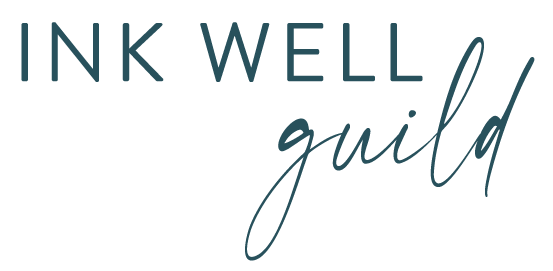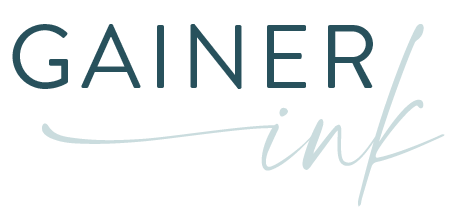Today we’re gonna talk about marketing for freelance writers, which is one of my favorite things to talk about. Yay marketing strategies!
On a recent episode of my podcast, Copy Chatter (the podcast where we talk about all the things for your freelance writing business!),we talked about this very thing.
There are basically two main options of marketing strategies for freelance writers, two kinds of umbrellas that your marketing is going to fall under. One of these umbrellas is called outbound marketing and the other one is inbound marketing. So, what is the difference? Which umbrella should you choose?
Two Types of Marketing for Freelance Writers
Outbound marketing is when you go to the clients. Usually it means you are going out and asking for work, but not always. It could just be you putting yourself out there.
People really don’t like this because it seems like a lot of work and it seems like you’ve got a lot on the line. For example, when you send an email to a potential client, you’re sort of begging to be rejected and nobody likes that!
Inbound marketing is when you set things up in such a way that the clients come to you, which is awesome! Inbound marketing is kind of the holy grail of freelance service providers.
We always want people to come to us because it’s easier that way.
Inbound marketing takes away a lot of the risk of rejection. As humans with feelings, we like to minimize the risk of rejection as much as we can! Inbound marketing is something that really appeals to a lot of people because it seems easier, not as scary or intimidating.
That’s why inbound appeals to most people and outbound turns most people off. However, there are pitfalls on either side.
I recommend that you use a mix of both. If you are relatively new to the scene or if you are in a situation where you need or want to start making money fairly quickly, you’re going to have to do outbound marketing, because the inbound stuff just takes time.
A lot of inbound relies on search engine juice. A lot of it depends on people being able to find you. And so you have to leave these trails of breadcrumbs. My ghostwriting mentor, Derrick Lewis, talks about as you leave your breadcrumbs, it takes awhile to place them and it takes awhile for people to start finding them. If you need money fast, you’re going to have to start doing some outbound marketing.
But I promised you specifics, and I’m going to deliver!

Outbound Marketing
When we hear outbound marketing, the most commonly thought of strategy is sending emails.
Feeling Hot, Hot, Hot
These are usually called cold emails. One of my role models is Ed Gandia and he talks about the difference between cold email prospecting and warm email prospecting. I really liked the distinction he made, because I think it matters. Number one, he really knows what he’s talking about. Number two, it’s a really insightful distinction.
Either way, what you’re doing is sending an email to somebody who doesn’t know who you are, isn’t expecting to hear from you, and may or may not even need your services. You’re saying, “Hey, I’m a writer, would you like to hire me?” Of course, you’re doing it in a much more sophisticated way than that, but that’s essentially what you’re doing!
The difference between a cold email and a warm email is one way that marketers talk about leads and potential clients. They talk about the hot, the warm, and the cold.
The hot audience is people who already know you, they love you, they want whatever you’re going to offer. (Yes, please!!)
The warm audience may know you, and they’re kind of interested once they come across you. (A solid maybe?)
The cold audience has no idea what you know, who you are, or what you’re doing. If you think about your prospects as your audience, your cold emails are literally showing up in someone’s inbox unbidden, unannounced, and you’re saying, “Hey, I’m a writer, would you like to hire me?”
It works for some people. It actually works for a lot of people. But a lot of people really don’t like this method. They feel very uncomfortable. It feels intrusive in a way, like a waste of time.
Warm emails are a little bit better. They’re a little bit easier to send. They are a lot more fun to write. They’re also going to get you better results. What sets a warm email apart from a cold email is that in a warm email you find some kind of way to build rapport or connection with the person you’re writing.
So you aren’t just saying, “Hey, I’m a writer. Do you want to hire me?”
You would go into a warm email saying something like, “Hey, I really admire what your company is doing. I think you guys are awesome. I love this, this, and this part of your mission statement. I’m a freelance writer. I specialize in blah, blah, blah, and I would really, really love to join your marketing team.”
You’re praising them, you’re building a connection. You’re warming them up in a sense. It’s not scammy and it’s not gross. It’s just making a connection. You are a person and they are a person and we are people and people hire people and people need people and all you’re doing is just, you know, peopling. (I made that up but it totally should be a word!)
There are lots of different ways you can do a warm email. You can praise the company for what they’re doing. You can look for some recent news about them and congratulate them on whatever this news is. That makes it warm because you’re making it clear that you are paying attention to them. You’re offering them congratulations. That’s pretty cool.
Drop ‘Em Like They’re Warm
Another way to do a warm email is if you were referred to them by somebody and you can say, “Hey, Ashley told me you’re looking for a writer. I would love to help you out.” That’s a pretty warm email that you could send.
It’s not always easy to do that, but when you have the opportunity, drop those names. If you have a personal connection with the person you’re emailing, make sure that you mention that personal connection. Of course, run it by the person you want to mention first and say, “Hey, I’m sending an email to Bob to see if he needs a writer because you mentioned that he’s really frazzled. Do you mind if I mention in the email that we know each other?”
Most people are going to be like, “Yeah, sure. That’s awesome. I’ll put in a good word for you.” That’s a really warm email that you can send!
This is how I’ve landed some really fun work. Some of my favorite work, really.
Of course there are other ways that you can do outbound marketing, like applying for gigs on job boards, or connecting with people on LinkedIn and seeing if they need writers. But ultimately outbound is how a lot of people find work. It’s also something that a lot of new freelancers really want to avoid… and that’s why they don’t really get anywhere.
Inbound Marketing
Now let’s talk about inbound. Most people prefer inbound since it feels so much more comfortable. (I’ve also gotten pretty good results with inbound, so am not going to say either way one is better than the other. It really depends on your commitment level and your personality type.)
I get a lot of questions from people about how to do inbound marketing, even if they don’t necessarily know that’s what they’re asking. Just the other day, someone asked, “how do I find writing clients without having to send emails?”
Well, there are a few things you could do.
The main form of inbound marketing that has worked for me is my personal connections. Most of my work has come to me through people who send people my way.
This looks like anything from participating in a Facebook group to tweeting on Twitter.
Other types of inbound are things like optimizing your Facebook and LinkedIn profiles so that you have the right keywords. When people go on LinkedIn–which I think is a really underutilized platform–they may be looking for a copywriter in XYZ niche or a ghostwriter in HR or animal husbandry or whatever!
If you are that person and you have those keywords in your profile, you’re going to get found.
SEO
Speaking of keywords, inbound marketing depends a lot on SEO. I hesitate to mention SEO because then we start talking about websites and websites are a big black hole vortex of doom for a lot of writers, especially new writers. (No, I’m not exaggerating, why do you ask?)
So I don’t want to emphasize your website too much. I also don’t really want to underemphasize it, either. I teach that you don’t have to have a website on day one and that you can get started before you have a website. GASP start without a website? Yup. It’s a thing.
You probably do need to get a website at some point, though. One of the main benefits of the website other than showcasing you as a service provider is the SEO. You only really get SEO if you are using WordPress, which I know is intimidating for a lot of new folks, but WordPress is how you get SEO. It just is.
For SEO, you have to do keyword research to figure out what kinds of keywords you want to use in your website to make it easier for people to find you. You need to make sure that you have your keywords, and you need to have content that’s being updated regularly. The easiest way to do this is with a blog (like this here little ol’ blog you’re a readin’ now!). You need to be updating once a month, maybe twice a month. Don’t spend more time on your blog than that.
SEO is not a winning strategy if you are coming in without any other stuff going on. However, if you have a website, it is something you should be paying attention to.
Related to a blog is Pinterest. If you have a blog attached to your writer site and your audience is the audience who will hire you, then you can get your stuff circulating on Pinterest and you can get a lot of inbound marketing that way. I’m not a Pinterest expert, but I know this is a thing that works for some people.
Attraction Marketing
Any kind of social media really is inbound marketing. There’s a specific type of inbound marketing that relates to a lot of the other types that I’ve already mentioned: attraction marketing. Attraction marketing is a type of inbound marketing. Some might say that they’re basically the same thing; in a lot of ways, they are kind of the same thing.
But for me, I’m talking about attraction marketing specifically on Facebook. Make Facebook your funnel. If you’re familiar with the language of sales funnels, just know that Facebook can be a funnel. (You can do it with LinkedIn, too, just not as much.)
You want to optimize your Facebook profile as much as you can to make it very clear that you are a freelance writer. And you are for hire.
It takes kind of a mind shift that to go from Facebook as a personal tool to Facebook as a work tool. Some people really find that a struggle. If you’re having a hard time, use a business page instead for your marketing.
If you want to do attraction marketing, Facebook groups are your golden ticket because that is how people find you and what you do.
The basics of attraction marketing are that you get into Facebook groups where your ideal client is hanging out and you answer questions and you become tremendously helpful and you are not in there pitching your work. You are in there to get noticed as someone who knows what they are doing and who is a writer.
This works really, really well if your market is in any kind of entrepreneurial space. If you want to write for relationship coaches or wedding photographers or bloggers or mompreneurs or whoever you want to write for. If they are the type of people who congregate on Facebook, then what you do is you get in the groups where they are going to go and start asking questions that they have about their business.
Any time someone asks a question about content or writing or you know, editorial calendars or how are you so productive or anything like that, you answer, you just answer, answer, answer! You give your best advice, you give your best tips.
Then if your profile is optimized, people are like, “Huh, who is this Ashley person who knows everything there is to know about blog posts?” And they click over to your profile page, or now they can click over to your business page if you’re interacting in these groups with you under your business name and they can see, oh, she’s a freelance writer. And then it becomes, oh, maybe she can write for me. And then they send you a message and you’re off to the money races!
So that’s what attraction marketing looks like.
Referral Network
Inbound marketing can also be if my friend needs a writer and she’s like, “Hey Ashley, can you do this writing for me?” Yes!
Anything that comes from your contacts comes from your network. That’s inbound marketing! Being visible and active on social media platforms makes it much easier for people to do that. It makes it really easy for people to remember, oh, Ashley’s the one who’s always writing about this and that and the other. And-so and-so needs a writer, so I’m going to connect them.
The last thing I wanted to offer for inbound marketing is if you write a book and you self publish this book on Amazon. This can also sometimes be a small (and I want to emphasize small!) stream of revenue for you. You want to make it something that is going to be easily found by your target clients.
I used to write for a welding equipment company. If I wanted to write for more of them, what I might do is go on to Amazon and self-publish a book on content marketing strategies for welders, content marketing strategies for welding equipment or for industrial businesses or whatever. You can pick whatever your target industry is and write a book about strategies related to the service that you offer for that industry.
If I’m writing for WordPress blogs and I want to get noticed, I might write a book about the best marketing strategies for technology blogs or something like that. Then people might see that you’ve written a book. Maybe they’ll buy your book, but more likely they might say, well, who is this person?
And then you have your Amazon author profile and it says Ashley Gainer is a freelance writer specializing in welding equipment and she can be reached at her website, AshleyGainer.com. And then they come to you and it’s amazing. (Slam dunk, attraction and inbound marketing!)
Finding Freelance Writing Clients
Now, I have something for you.
I’m very excited to announce that I have just released a new course and I’m so excited about it! It’s called Client Bound.
We talked about outbound marketing, we talked about inbound marketing and if you employ any of these strategies you are going to be client bound! Client Bound is a self-guided kind of a self-serve course for you with videos, handouts and worksheets, dozens of lessons, and lists of marketing agencies that are hiring writers.
People say that finding freelance writing clients is really hard. In my experience it’s actually not that hard!
The thing that is hard is dealing with the overwhelm, the confusion, the not knowing what to do, the not knowing what to try, the not knowing which way is the best thing. It’s more of a mind game.
What I do is demystify the process, lay everything out. You can pick what you want to do, you can discard what you want to do, but it’s all right there. You don’t have to go searching, you don’t have to go reading a bazillion different blogs to figure out this and that strategy.
It’s everything I know about finding clients and I am just so excited to share it with you! So go get it. It’s copy chatter.com/clients and I cannot wait to see you on the inside!





Pingback: Where to Find Freelance Writing Clients that Pay Better than Upwork — Ashley Gainer